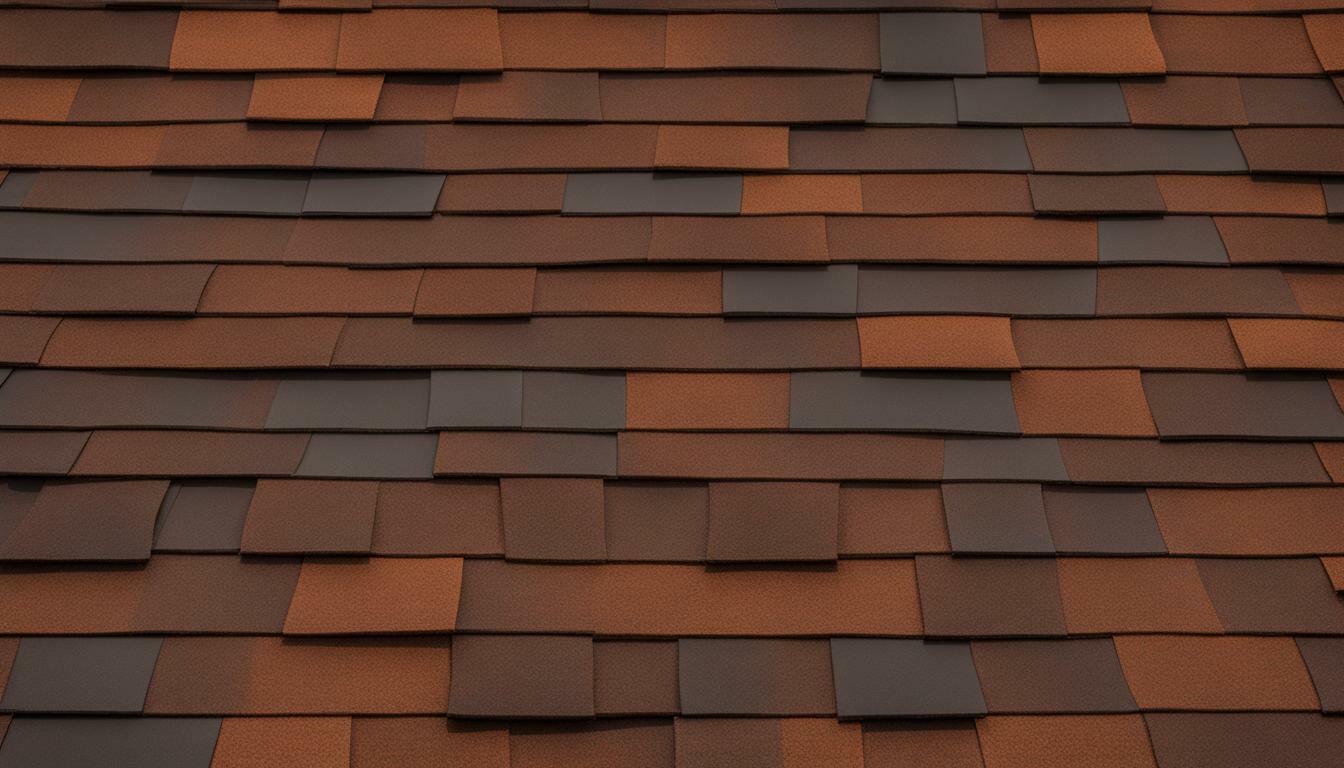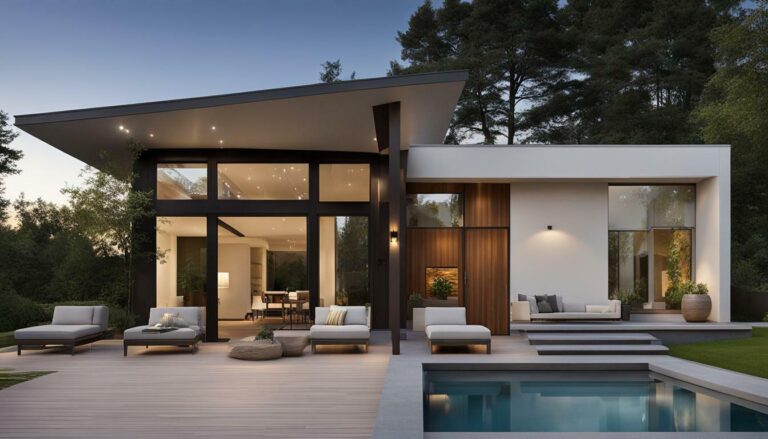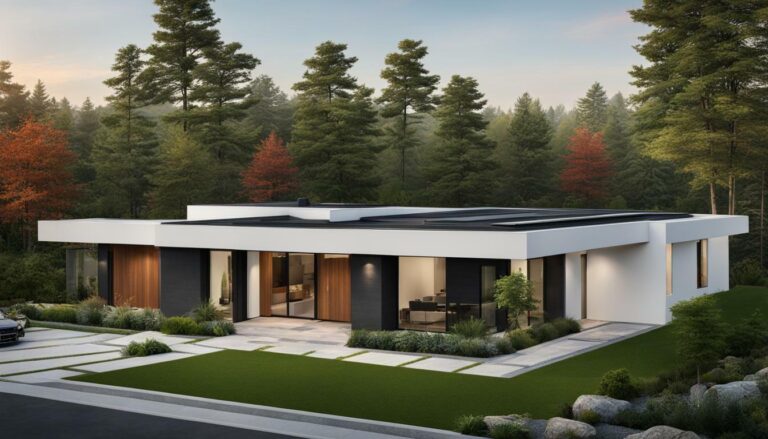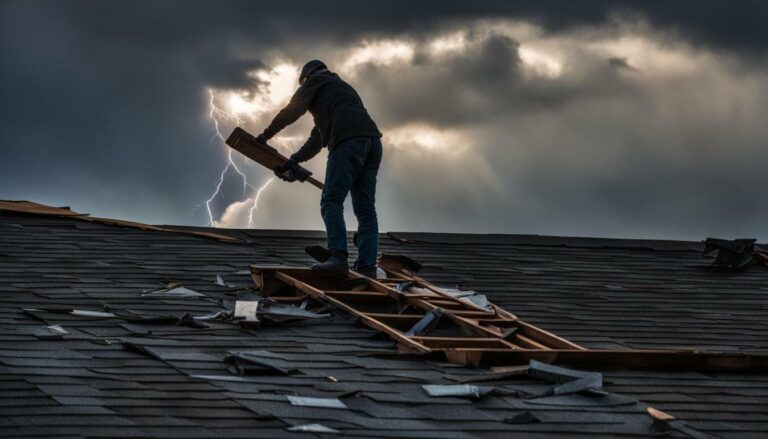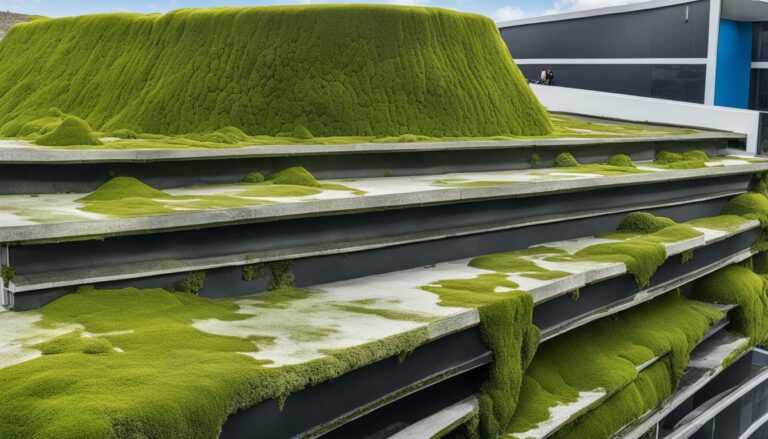Discover Sustainable Roofing Materials for Your Green Home.
As you strive to create a green home, one crucial aspect to consider is the selection of sustainable roofing materials. Choosing eco-friendly roofing options not only helps to reduce your carbon footprint but also contributes to a greener planet. There are several environmentally friendly roofs available in the market that offer numerous benefits, such as energy efficiency, durability, and aesthetic appeal. By opting for sustainable roof systems, you can make a positive impact on the environment and save money in the long run. Let’s explore some of the top sustainable roofing materials that can transform your home into an eco-friendly haven.
Key Takeaways:
- Sustainable roofing materials are essential for reducing your carbon footprint and saving money.
- Options like white roofs, standing-seam metal roofs, shingle roofs made from sustainable wood shake or recycled materials, corrugated roofing, reclaimed slate or clay roofs, green roofs, and rubber roofing are all eco-friendly choices.
- Consider factors like durability, energy efficiency, cost, style, and environmental impact when selecting a roofing material.
- Eco-friendly roofing materials can significantly reduce your home’s carbon footprint and help protect the environment.
- Choosing sustainable roof systems contributes to a greener planet and promotes a more sustainable lifestyle.
Understanding the Importance of Sustainable Roofing Materials
By opting for sustainable roofing materials, you are making a conscious choice to minimize the negative impact of your home on the environment. Sustainable roof choices go beyond just reducing your carbon footprint; they also offer long-term benefits and cost savings. Traditional roofing materials, such as asphalt shingles, contribute to landfill waste and require frequent replacement. On the other hand, sustainable roofing solutions are designed to be durable, long-lasting, and energy-efficient.
One of the main reasons to consider sustainable roofing materials is their positive impact on the environment. By using eco-friendly roofs, you are reducing the demand for non-renewable resources and decreasing the amount of waste generated. Additionally, sustainable roof materials often have higher insulating properties, which can help reduce energy consumption and lower utility bills.
Choosing sustainable roofing materials helps protect the environment and save money in the long run.
Another benefit of sustainable roofing solutions is their versatility. There are various options available, each with its own unique advantages. For example, white roofs reflect sunlight, reducing the need for air conditioning and lowering energy consumption. Standing-seam metal roofs are known for their durability and energy efficiency. Shingle roofs made from sustainable wood shake or recycled materials offer a vintage and eco-friendly choice. Corrugated roofing provides strength and sustainability, while reclaimed slate or clay roofs offer a unique aesthetic appeal and long lifespan. Green roofs incorporate vegetation, providing insulation and improving air quality. Rubber roofing is a sustainable choice for all climates due to its durability and use of recycled materials.
When selecting a sustainable roofing material for your green home, it’s essential to consider multiple factors. Durability is crucial to ensure your roof can withstand various weather conditions and last for many years. Energy efficiency is another important aspect, as it can lead to significant cost savings over time. Additionally, consider the cost of the material, its style and overall aesthetic appeal, and its environmental impact.
By investing in sustainable roofing materials, you are not only making a responsible choice for your home but also contributing to a greener planet. Consider the different options available, weigh their benefits, and make an informed decision that aligns with your eco-friendly lifestyle and long-term goals.
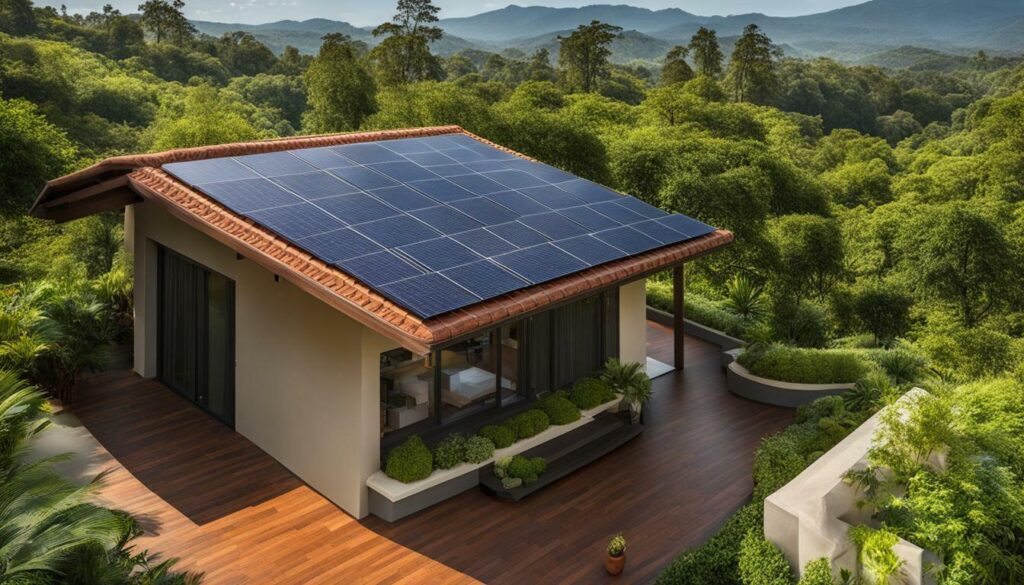
When it comes to sustainable roofing, there is a wide range of options to choose from, ensuring that you find the perfect fit for your green home. By selecting energy-efficient roofing materials, you can significantly reduce your carbon footprint and contribute to a more environmentally friendly future. Let’s explore some of the eco-friendly roofing materials available in the market:
- White Roofs: White roofs, also known as cool roofs, are designed to reflect sunlight, reducing the need for air conditioning and lowering energy consumption. They can help keep your home cool during hot summers, making them an excellent choice for energy efficiency.
- Standing-Seam Metal Roofs: These roofs are known for their durability and energy efficiency. Made from recyclable materials, standing-seam metal roofs can last for several decades with minimal maintenance. They are also highly resistant to extreme weather conditions, including wind and hail.
- Shingle Roofs: Shingle roofs made from sustainable wood shake or recycled materials are an eco-friendly choice. These materials are sourced and manufactured in an environmentally friendly manner, reducing the impact on natural resources. They offer both aesthetic appeal and durability.
- Corrugated Roofing: Corrugated roofing is known for its strength and sustainability. Made from recycled materials, it is lightweight yet durable, making it suitable for various climates. Corrugated roofs can withstand harsh weather conditions and have a long lifespan.

Reclaimed Slate or Clay Roofs: Choosing reclaimed slate or clay roofs not only adds a vintage touch to your home but also contributes to a sustainable future. These materials are known for their longevity, often lasting over a century. By using reclaimed materials, you are reducing the demand for new resources and minimizing waste.
Sustainable Roof Systems
When exploring eco-friendly roofing options, it’s worth considering sustainable roof systems. These systems are designed to maximize energy efficiency and reduce environmental impact. They often incorporate features such as solar panels, rainwater harvesting systems, and insulation to optimize your home’s energy consumption.
| Sustainable Roof System Features | Benefits |
|---|---|
| Solar Panels | Generate clean and renewable energy, reducing your reliance on fossil fuels. |
| Rainwater Harvesting Systems | Collect and reuse rainwater for irrigation, reducing water consumption. |
| Insulation | Improve energy efficiency by minimizing heat transfer and reducing heating or cooling needs. |
By incorporating sustainable roof systems into your green home, you can further enhance its energy efficiency and sustainability.
The Benefits of White Roofs
White roofs offer numerous advantages when it comes to sustainable roofing, making them an excellent choice for eco-conscious homeowners. One of the primary benefits of white roofs is their ability to reflect sunlight, reducing the amount of heat absorbed by your home. This reflective property helps to keep your home cooler during hot summer months, reducing the need for air conditioning and saving energy.
According to studies, white roofs can lower the temperature of your roof by up to 50 degrees Fahrenheit, resulting in significant energy savings. By reducing the heat absorption, white roofs also help to mitigate the urban heat island effect, where densely populated areas experience higher temperatures due to the abundance of dark surfaces.
“White roofs can significantly reduce the energy consumption of your home, leading to lower utility bills and a smaller carbon footprint.”
Furthermore, white roofs have a longer lifespan compared to traditional dark-colored roofs, as they are less prone to damage from UV rays. This durability means less frequent roof replacements, resulting in reduced waste in the landfill.
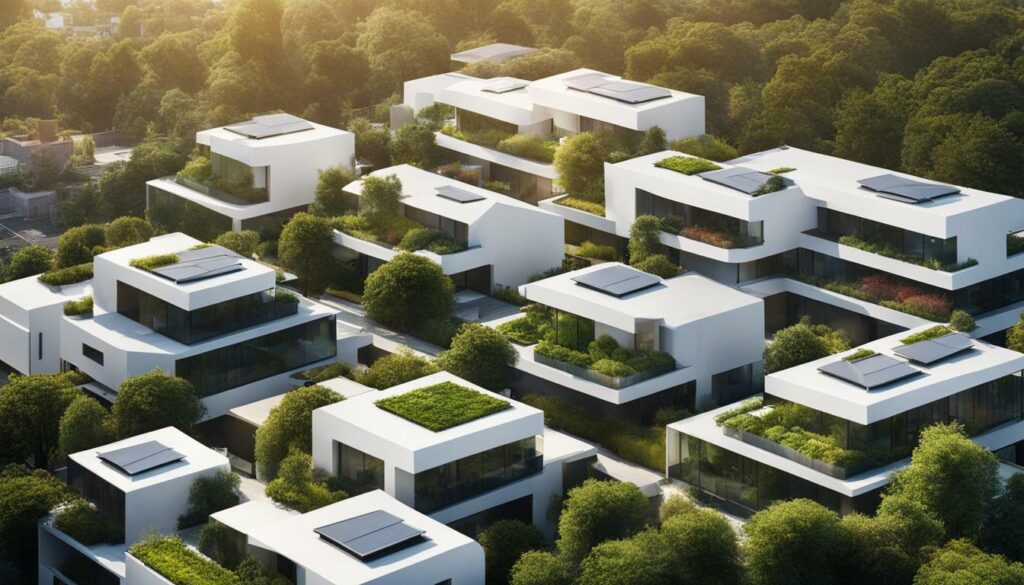
| Advantages of White Roofs |
|---|
| Increased energy efficiency |
| Lower cooling costs |
| Reduced urban heat island effect |
| Longer lifespan |
| Less waste in landfills |
In summary, white roofs are an eco-friendly choice for sustainable roofing due to their energy efficiency, cooling cost reduction, and ability to combat the urban heat island effect. Their durability and longer lifespan also contribute to less waste in landfills. When considering sustainable roofing materials for your green home, white roofs should be at the top of your list.
Standing-Seam Metal Roofs: Durability and Efficiency
If you are looking for a durable and energy-efficient option, standing-seam metal roofs are a great sustainable choice for your home. These roofs are known for their longevity and ability to withstand harsh weather conditions, making them a reliable and low-maintenance option. With proper installation and maintenance, standing-seam metal roofs can last for 50 years or more, saving you money on frequent replacements.
The design of standing-seam metal roofs also contributes to their energy efficiency. The raised seams create a watertight barrier, reducing the risk of leaks and improving insulation. Metal roofs reflect heat from the sun, preventing excessive heat absorption and reducing the need for air conditioning, especially during hot summer months.
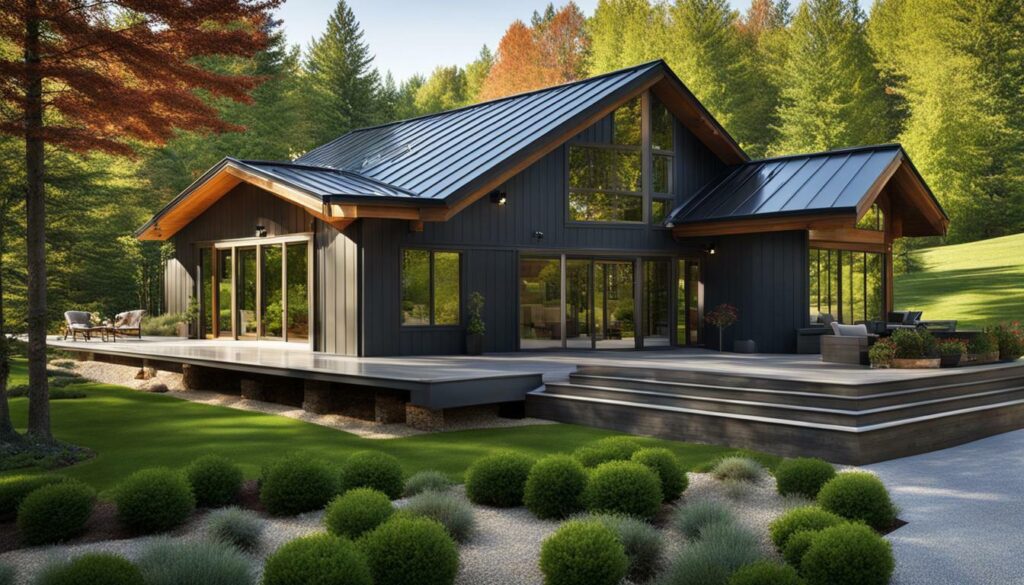
In addition to their durability and energy efficiency, standing-seam metal roofs are available in a variety of styles and colors, allowing you to find a design that suits your aesthetic preferences. Whether you prefer a traditional or modern look, there is a standing-seam metal roof option that can complement your home’s architecture.
Benefits of Standing-Seam Metal Roofs:
- Durable: With a lifespan of 50 years or more, standing-seam metal roofs offer long-term protection for your home.
- Energy-Efficient: Reflecting heat from the sun, metal roofs help reduce energy consumption for cooling.
- Versatile Design: Choose from a variety of styles and colors to match your home’s aesthetic.
- Low Maintenance: Metal roofs require minimal upkeep, saving you time and money in the long run.
Investing in a standing-seam metal roof not only benefits your home but also the environment. Metal roofs are often made from recycled materials and can be recycled again at the end of their lifespan, reducing landfill waste. Their energy-efficient properties also contribute to a greener planet by reducing carbon emissions associated with excessive cooling.
When considering sustainable roofing options, don’t overlook the durability and efficiency of standing-seam metal roofs. With their long lifespan, energy savings, and environmental benefits, they are a smart choice for your green home.
Shingle Roofs: Sustainable Wood Shake and Recycled Materials
Shingle roofs made from sustainable wood shake or recycled materials offer an eco-friendly alternative without compromising on style or durability. These roofing materials are not only visually appealing but also contribute to a greener future. By using sustainable wood shake or recycled materials, you can reduce the demand for new resources and prevent landfill waste.
One option for sustainable shingle roofs is using wood shake sourced from responsibly managed forests. These shingles are made from renewable materials and can be recycled at the end of their lifespan. By choosing sustainable wood shake shingles, you are supporting sustainable forestry practices and minimizing the environmental impact of your roof.
Another eco-friendly choice is shingle roofs made from recycled materials. These shingles are typically manufactured from recycled plastic or rubber, diverting materials from landfills and reducing the need for virgin resources. Despite being made from recycled materials, they offer the same level of durability and protection as traditional shingles.
Benefits of Shingle Roofs Made from Sustainable Wood Shake or Recycled Materials
- Environmentally friendly: Choosing sustainable roofing materials helps conserve natural resources and reduces waste.
- Energy-efficient: Shingle roofs provide insulation, reducing energy consumption for heating and cooling.
- Long-lasting: Sustainable wood shake and recycled material shingles are designed to withstand harsh weather conditions, ensuring the longevity of your roof.
- Aesthetic appeal: These eco-friendly shingles come in a variety of colors, textures, and styles, allowing you to achieve the desired look for your home.
By opting for shingle roofs made from sustainable wood shake or recycled materials, you can achieve a beautiful and durable roof while making a positive impact on the environment. Consider consulting with a roofing professional to explore the best options for your green home.
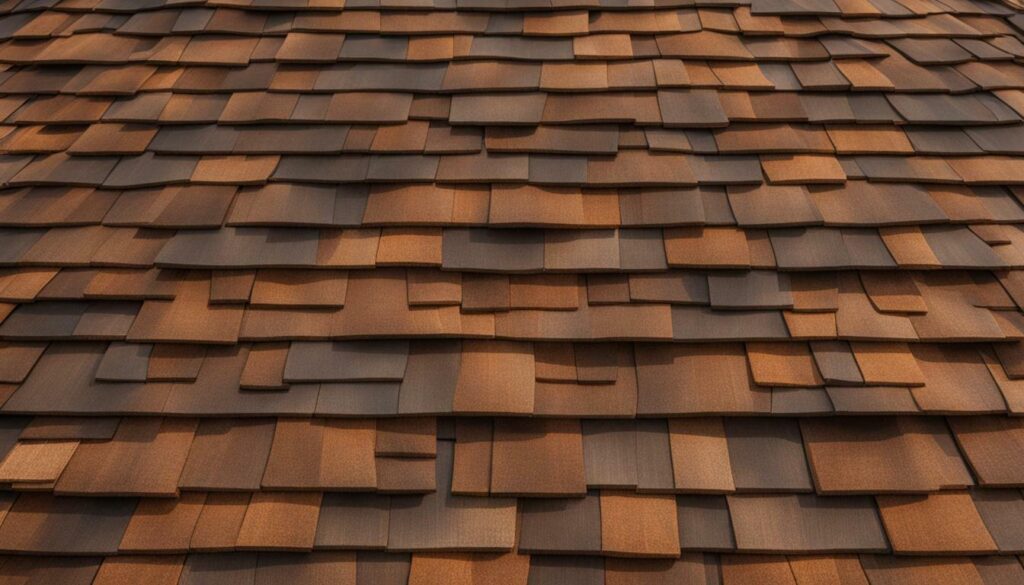
Corrugated roofing not only provides strength and protection, but it is also a sustainable choice for eco-conscious homeowners. Made from recyclable materials such as steel, aluminum, or polycarbonate, corrugated roofs have a minimal environmental impact. They are lightweight, easy to install, and highly durable, offering long-lasting performance.
One of the key benefits of corrugated roofing is its strength. The unique design of the corrugated panels adds rigidity, making them resistant to impact and extreme weather conditions. Whether it’s heavy rain, strong winds, or even hailstorms, corrugated roofs can withstand the elements, ensuring your home remains protected.
Additionally, corrugated roofs are energy-efficient. Their reflective properties help to reduce heat absorption, keeping your home cooler and reducing the need for air conditioning. By minimizing energy consumption, corrugated roofing contributes to lower utility bills and decreases your carbon footprint.
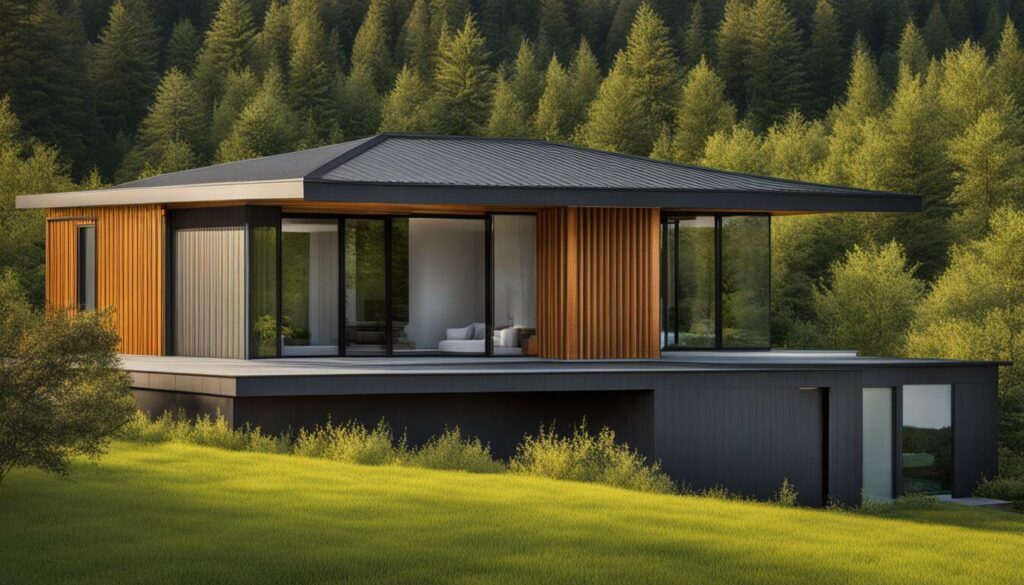
If you’re looking to incorporate corrugated roofing into your green home, it’s important to consider the installation process. Hiring a professional roofing contractor who specializes in sustainable roofing materials is recommended to ensure proper installation and maximize the benefits of this eco-friendly choice.
In summary, corrugated roofing offers both strength and sustainability. Its durability, energy efficiency, and recyclability make it an excellent choice for homeowners who want to reduce their environmental impact. By choosing corrugated roofing, you are not only protecting your home but also contributing to a greener planet.
Reclaimed Slate or Clay Roofs: A Vintage and Sustainable Choice
Reclaimed slate or clay roofs offer a vintage charm while being an eco-friendly option that aligns with your green home aspirations. These roofs are not only visually appealing but also contribute to sustainability by reducing landfill waste and minimizing the need for new roofing materials.
One of the key benefits of choosing reclaimed slate or clay roofs is their durability. Slate roofs, known for their longevity, can last upwards of 100 years when properly maintained. Similarly, clay roofs have a lifespan of 50 to 100 years. By opting for these materials, you are investing in a roofing solution that will stand the test of time.
Additionally, reclaimed slate or clay roofs offer excellent insulation properties. Their natural composition helps regulate indoor temperatures, keeping your home cooler in the summer and warmer in the winter. This directly contributes to energy savings and reduced reliance on heating or cooling systems.
| Benefits of Reclaimed Slate or Clay Roofs | Advantages |
|---|---|
| 1. Durability | Long lifespan of 50-100+ years. |
| 2. Energy Efficiency | Natural insulation properties reduce energy consumption. |
| 3. Sustainable Choice | Reduces landfill waste and minimizes the need for new materials. |
| 4. Visual Appeal | Enhances the aesthetic appeal of your green home. |
When considering reclaimed slate or clay roofs, it’s important to note that these materials require professional installation and regular maintenance to ensure their longevity. Working with experienced roofers who specialize in reclaimed roofing can help ensure proper installation and adequate upkeep.
By choosing reclaimed slate or clay roofs for your green home, you are making a sustainable choice that aligns with your environmental values. Their durability, energy efficiency, and unique aesthetic appeal make them an excellent option for homeowners looking to embrace eco-friendly roofing materials.
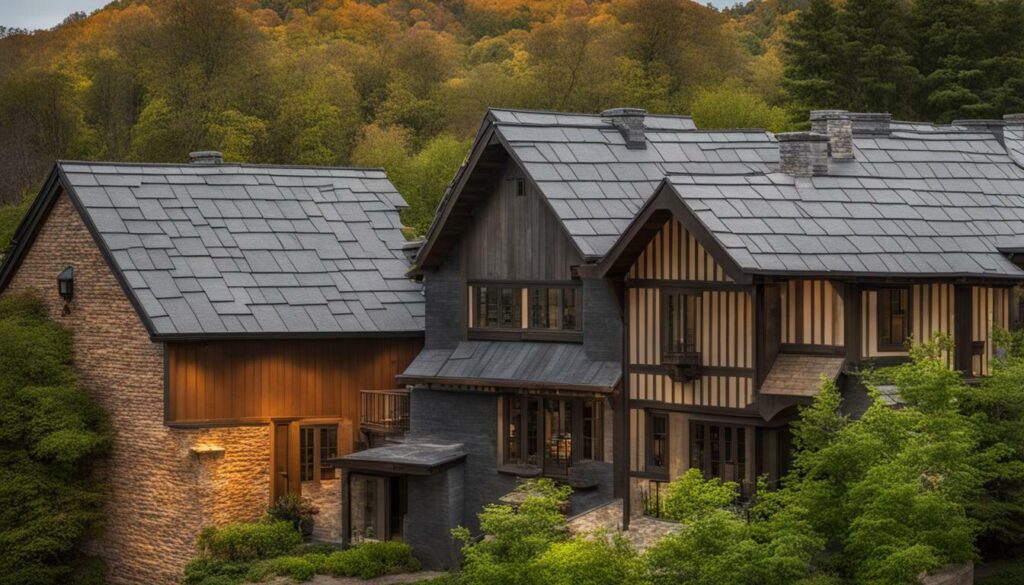
Green roofs offer a natural and resource-efficient solution that not only enhances the aesthetics of your home but also contributes to a sustainable future. These unique roof systems are designed to incorporate vegetation, providing a range of benefits for both the environment and homeowners. By choosing a green roof, you can create a vibrant and eco-friendly space that helps reduce energy consumption, improves air quality, and minimizes stormwater runoff.
One of the key advantages of green roofs is their ability to provide insulation. The layer of vegetation acts as a natural barrier, reducing heat transfer and keeping your home cooler in the summer and warmer in the winter. This can significantly decrease your reliance on heating and cooling systems, leading to lower energy bills and reduced carbon emissions. Additionally, green roofs help purify the air by filtering out pollutants and capturing greenhouse gases, contributing to cleaner and healthier surroundings.
When it comes to stormwater management, green roofs excel at retaining and absorbing rainwater. The vegetation and substrate layers of these roofs can retain a substantial amount of water, preventing it from immediately entering storm drains and overloading the sewage system. This helps mitigate the risk of flooding, reduce erosion, and replenish groundwater levels. By minimizing stormwater runoff, green roofs play a crucial role in protecting our natural water resources and promoting a sustainable water cycle.
Reducing the Urban Heat Island Effect
Another significant benefit of green roofs is their role in combating the urban heat island effect. In urban areas, the vast expanse of concrete and asphalt absorbs and emits heat, leading to increased temperatures. Green roofs, on the other hand, absorb heat and release it slowly, creating a cooling effect that offsets the urban heat island effect. This not only helps to lower ambient temperatures but can also improve the overall livability of cities by providing green spaces and promoting biodiversity.
| Benefits of Green Roofs | SEO Keywords |
|---|---|
| Energy-efficient insulation | green roofs |
| Air quality improvement | green roofs |
| Stormwater management | green roofs |
| Reduction of urban heat island effect | green roofs |

When considering sustainable roofing options for your green home, green roofs present numerous advantages that can significantly contribute to a more eco-friendly lifestyle. By incorporating a green roof into your home design, you not only enhance the visual appeal of your property but also make a positive impact on the environment. So, why not explore the possibilities of green roofs and join the movement towards a greener and more sustainable future?
Rubber Roofing: A Sustainable Choice for All Climates
Rubber roofing provides a sustainable and versatile option suitable for all climates, making it an ideal choice for eco-friendly homeowners. Made from recycled materials, rubber roofs offer durability, energy efficiency, and contribute to reducing landfill waste. Whether you live in a hot, cold, or moderate climate, rubber roofing can withstand the elements and provide excellent protection for your green home.
One of the key advantages of rubber roofing is its ability to withstand extreme temperatures. Whether it is scorching hot or freezing cold, rubber roofs maintain their integrity and provide reliable protection. This durability ensures that your roof will last for many years, reducing the need for frequent replacements and minimizing waste.
In addition to its durability, rubber roofing is also highly energy-efficient. Its reflective surface helps to reduce heat absorption, keeping your home cooler in the summer months and reducing the need for excessive air conditioning. By lowering your energy consumption, rubber roofs can help you save on utility bills while making your home more environmentally friendly.
As an environmentally friendly option, rubber roofing also contributes to reducing landfill waste. Made from recycled materials, rubber roofs repurpose materials that would otherwise end up in landfills. This sustainable approach not only helps protect the environment but also supports the circular economy by giving new life to old materials.

- Highly durable and weather-resistant
- Energy-efficient, reducing utility costs
- Made from recycled materials, reducing landfill waste
- Easy to install and maintain
- Versatile, suitable for all climates
When considering sustainable roofing options for your green home, rubber roofing is a top choice. Its durability, energy efficiency, and contribution to reducing landfill waste make it an environmentally conscious option. Consult with a roofing professional to explore the benefits of rubber roofing and determine if it is the right fit for your home. By investing in a rubber roof, you can protect both your home and the environment.
Making the Right Choice for Your Sustainable Roofing Needs
When it comes to sustainable roofing materials, it is crucial to make an informed choice that aligns with your priorities, budget, and environmental values. Discovering sustainable roofing materials for your green home is essential for reducing your carbon footprint and saving money in the long run. There are various eco-friendly options to choose from, each with its own benefits.
Consider options like white roofs, standing-seam metal roofs, shingle roofs made from sustainable wood shake or recycled materials, corrugated roofing, reclaimed slate or clay roofs, green roofs, and rubber roofing. These materials are durable, long-lasting, energy-efficient, and can help reduce landfill waste.
When selecting a roofing material, factors to consider include durability, energy efficiency, cost, style, and environmental impact. Sustainable roof choices not only contribute to a greener planet but also offer financial savings through reduced energy consumption and lower maintenance costs. It’s important to assess the lifespan of the materials, their ability to withstand weather conditions in your area, and the overall aesthetic appeal they bring to your home.
By choosing environmentally friendly roofs, you are not only making a positive impact on the environment but also creating a healthier living space for you and your family. The right sustainable roofing materials can improve insulation, reduce energy usage, and even enhance the air quality in your home. Additionally, many sustainable roofing options are made from recycled or reclaimed materials, further reducing the strain on natural resources.
In summary, selecting a sustainable roofing material for your green home is a decision that requires careful consideration. Analyze your priorities, budget, and environmental values to determine the best choice for your needs. By choosing environmentally friendly roofs that align with your values, you can significantly reduce your home’s carbon footprint, contribute to a greener planet, and create a more sustainable future for generations to come.
FAQ
Q: Why is it important to choose sustainable roofing materials for a green home?
A: Choosing sustainable roofing materials is essential for reducing your carbon footprint and saving money in the long run. These materials are durable, long-lasting, energy-efficient, and can help reduce landfill waste, making them an environmentally responsible choice for your green home.
Q: What are some eco-friendly roofing options available for green homes?
A: There are various eco-friendly roofing options to choose from, including white roofs, standing-seam metal roofs, shingle roofs made from sustainable wood shake or recycled materials, corrugated roofing, reclaimed slate or clay roofs, green roofs, and rubber roofing. Each option offers its own unique benefits and contributes to a greener planet.
Q: How can white roofs contribute to sustainability?
A: White roofs have the ability to reflect sunlight, reducing the need for air conditioning and lowering energy consumption. By keeping the building cooler, white roofs contribute to energy efficiency and help reduce carbon emissions.
Q: What are the advantages of standing-seam metal roofs?
A: Standing-seam metal roofs are known for their durability and energy efficiency. They are made from recyclable materials and have a long lifespan, reducing the need for replacement. Additionally, their design allows for effective rainwater collection and solar panel installation.
Q: What are shingle roofs made from sustainable wood shake or recycled materials?
A: Shingle roofs made from sustainable wood shake or recycled materials are an eco-friendly alternative to traditional shingles. Sustainable wood shake is sourced from responsibly managed forests, while recycled materials help reduce waste and promote circularity. These roofs are both aesthetically pleasing and environmentally conscious.
Q: What are the benefits of corrugated roofing?
A: Corrugated roofing is known for its strength, durability, and sustainability. It is resistant to extreme weather conditions and can withstand impact. Additionally, corrugated roofing is made from recyclable materials, making it an environmentally friendly choice for your green home.
Q: Why should I consider reclaimed slate or clay roofs?
A: Reclaimed slate or clay roofs offer a vintage and sustainable option for your green home. These materials have a long lifespan and can be sourced from salvaged materials, reducing the demand for new resources. They also provide a unique aesthetic appeal and are highly durable.
Q: What are green roofs and how do they contribute to sustainability?
A: Green roofs are roofs that incorporate vegetation, providing insulation, improving air quality, and reducing energy consumption. They help regulate temperature, reduce stormwater runoff, and promote biodiversity. Green roofs are a natural and energy-efficient solution for sustainable living.
Q: Why is rubber roofing a sustainable choice for all climates?
A: Rubber roofing is manufactured from recycled materials, making it an environmentally friendly option. It is highly durable and can withstand challenging weather conditions, making it suitable for all climates. Rubber roofing helps reduce landfill waste and contributes to a greener planet.
Q: What factors should I consider when selecting a sustainable roofing material?
A: When selecting a sustainable roofing material for your green home, factors to consider include durability, energy efficiency, cost, style, and environmental impact. It is important to choose a material that aligns with your needs and values while minimizing your carbon footprint and protecting the environment.
